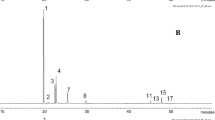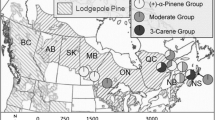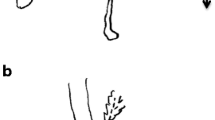Abstract
This paper presents preliminary results on attempts to extract and characterize the volatile secondary metabolites contained in needles of differentPinus species and to ascertain the role played by these substances on the behavior ofThaumetopoea pityocampa (Denis et Schiffermüller) females, which show a marked preference, during the oviposition period, for some indigenous and exotic species of host plants existing in mixed formation. Limonene is the most abundant monoterpene extracted fromP. pinea needles, the least favored species of pine processionary caterpillar (PPC) females, although it is present in only very low amounts in otherPinus species. An increase was observed in limonene production byP. pinea at the start of the flight period of the PPC adult, and subsequently at the beginning of the females’ oviposition period. Assays carried out in two pine stands in central Italy showed that limonene, emulsified with water and sprayed on foliage of four different pine species plants,P. sylvestris, P. nigra, P. pinaster andP. radiata, during the PPC oviposition period, provided a satisfactory degree of protection. In fact, the number of egg clusters collected from treated plants was often lower than the number of egg clusters collected from control plants and was comparable to the number of egg clusters laid onP. pinea plants. In particular (R)-(+)-limonene, although not produced in nature by pines, was the most effective deterrent. However, the effect of (S)-(-)-limonene, the enantiomer biosynthesized by pines, was also adequate.
Similar content being viewed by others
References
Altaro, R.I., Pierce, H.D., Jr., Borden, J.H. and Oehlschlager, A.C. (1980) Role of volatile and nonvolatile components of Sitka spruce bark as feeding stimulants forPissodes strobi Peck (Coleoptera: Curculionidae).Can. J. Zool. 58:626–632.
Battisti, A. (1989)Thaumetopoea pityocampa: bio-ecologia e problemi di energetica in ecosistemi di pineta.Atti Convegno Awersità del Bosco e delle Specie Arboree da Legno (Firenze, Italy, 1987), pp. 223–234.
Buxton, R.D. (1990) The influence of host tree species on timing of pupation ofThaumetopoea pityocampa Schiff. (Lep. Thaumetopoeidae) and its exposure to parasitism byPhryxe caudata Rond (Dipt., Larvaevoridae).J. Appl. Entomol. 109:302–310.
Calas, J. (1897) La Processionaire du Pin(Cnethocampa pityocampa). Rev. des Eaux et Forêt, pp. 705–723.
Geri, C. (1980) Étude sur les populations de processionnaire du pin (Thaumetopoea pityocampa Schiff., Lepidoptera Thaumetopoeidae).in: Grison, P. [Ed.] Études Écologiques et Ethnologiques dans le Niolu. Ch. VII.Ecol. Mediterr. 6:151–172.
Geri, C. (1983) Répartition et évolution des populations de la processionnaire du pin,Thaumetopoea pityocampa Schiff., (Lep., Thaumetopoeidae) dans les montagnes corses. 1. Régimes d’apparition de l’insecte et dynamique des populations.Acta Oecol. Oecol. Appl. 4:247–268.
Halperin, J. (1990) Life history ofThaumetopoea spp. (Lep., Thaumetopoeidae) in Israel.J. Appl. Entomol. 110:1–6.
Huchon, H. and Demolin, G. (1970) La bioécologie de la Processionnaire du pin, dispersion potentielle, dispersion actuelle.Rev. For. Fr. n. sp. La Lutte Biologique en Forêt pp. 220–233.
Jactel, H., Kleinhentz, M., Marpeau-Bezard, A., Marion-Poll, F., Menassieu, P. and Burban, C. (1996) Terpene variations in maritime pine constitutive oleoresin related to host tree selection byDioryctria sylverstella Ratz. (Lepidoptera: Pyralidae).J. Chem. Ecol. 22:1037–1050.
Leather, S.R. (1987) Pine monoterpenes stimulate oviposition in the pine beauty moth,Panolis flammea. Entomol. Exp. Appl. 43:295–303.
Leather, S.R., Watt, A.D. and Barbour, D.A. (1985) The effect of host-plant and delayed mating on the fecundity and lifespan of the pine beauty moth,Panolis flammea (Denis & Schiffermüller) (Lepidoptera: Noctuidae): their influence on population dynamics and relevance to pest management.Bull. Entomol. Res. 75:641–651.
Masutti, L. (1964) Ricerche sui parassiti oofagi dellaThaumetopoea pityocampa Schiff.Ann. Centro Econ. Mont. Venezie 4:205–271.
Masutti, L. and Battisti, A. (1990)Thaumetopoea pityocampa (Den. & Schiff.) in Italy. Bionomics and perspectives of integrated control.J. Appl. Entomol. 110:229–234.
Mendel, Z. (1988) Host selection by the pine processionary caterpillarThawnetopoea wilkinsoni.Phytoparaxitica 16:101–108.
Mori, K. (1998) Semiochemicals — Synthesis, Stereochemistry and Bioactivity.Eur. J. Org. Chem. 1479–1489.
Sadof, C.S. and Grant, G.G. (1997) Monoterpene composition ofPinus sylvestris varieties resistant and susceptible toDioryctria zimmermani.J. Chem. Ecol. 23:1917–1927.
Schopf, R. and Avtzis, N. (1987) Die Bedeutung von Nadelinhaltsstoffen für die Disposition von fünf Kiefernarten gegenüberThaumetopoea pityocampa (Schiff.).J. Appl. Entomol. 103:340–350.
Shu, S., Grant, G.G., Langevin, D., Lombardo, D.A. and MacDonald, L. (1997) Oviposition and electroantennogram responses ofDioryctria abietivorella (Lepidoptera: Pyralidae) elicited by monoterpenes and enantiomers from eastern white pine.J. Chem. Ecol. 23:35–50.
Stadler, E. (1974) Host plant stimuli affecting oviposition behavior of the eastern spruce budworm.Entoinol. Exp. Appl. 17:176–188.
Tiberi, R. (1983) Sulla distribuzione delle ovature diThaumetopoea pityocampa (Den. & Schiff.) in un giovane impianto diPinus pinaster eP. insignis.Redia 66:603–614.
Tiberi, R. (1989)Thawnetopoea pityocampa: convenienza delle iniziative di controllo e possibilità di interverti razionali.Atti Convegno Avversità del Bosco e delle Specie Arboree da Legno (Firenze, Italy, 1987), pp. 313–323.
Author information
Authors and Affiliations
Corresponding author
Rights and permissions
About this article
Cite this article
Tiberi, R., Niccoli, A., Curini, M. et al. The role of the monoterpene composition inPinus spp. needles, in host selection by the pine processionary caterpillar,Thaumetopoea pityocampa . Phytoparasitica 27, 263–272 (1999). https://doi.org/10.1007/BF02981482
Received:
Revised:
Issue Date:
DOI: https://doi.org/10.1007/BF02981482




